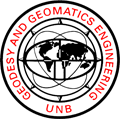Application of GPS as a New Remote Sensing Tool:
Retrieval of Ocean Surface Wind Speed
Attila Komjathy
Colorado Center for Astrodynamics Research (CCAR)
Department of Aerospace Engineering
University of Colorado
27 October 1998
Global Positioning System (GPS) signals reflected from the Ocean's surface have the potential to be used for various remote sensing purposes. Some possibilities are measurements of surface roughness characteristics from which wind speed, direction, and wave height could be determined. For this seminar, GPS reflected signal measurements taken from aircraft by a modified GPS receiver are used to explore the possibility of determining wind speed. When taking GPS measurements, the modified GPS receiver cross-correlates its C/A code signal replica with time-delayed surface-reflected GPS signals, which are affected by, e.g., sea surface wind conditions. To interpret these measurements, a theoretical model has been developed which describes the power of the reflected GPS signals for different time-delays as a function of geometrical and environmental parameters. The resulting waveforms indicate a good agreement between the measured and the modelled normalized signal power even during rapidly changing surface wind conditions. The inferred wind speed, obtained by comparing actual and modelled waveforms, shows good agreement (within 2 m/s) with wind data obtained from a nearby buoy and TOPOEX/Poseidon wind speed measurements.
Those interested in further details about this exciting new research area are invited to consult the presentation viewgraphs (Zipped PostScript, 614 KB) and a paper (UNIX-compressed PostScript, 181 KB) on the research accepted for publication in the journal Remote Sensing of Environment.


